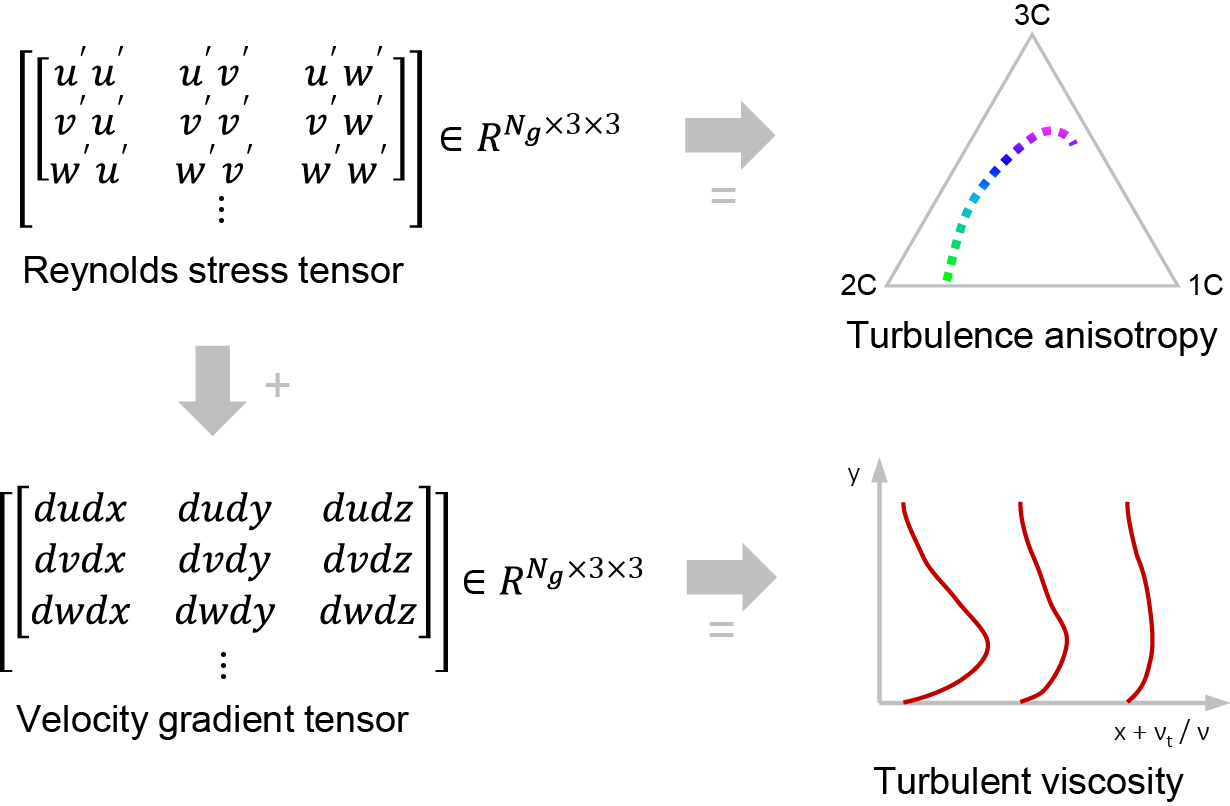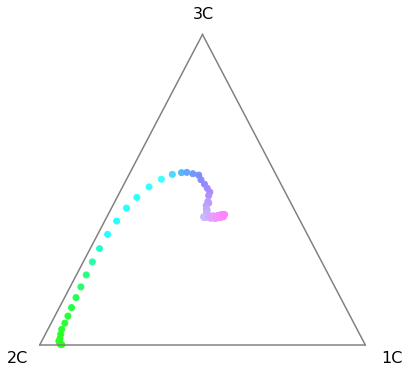This repository contains a Python toolkit that calculates and visualizes turbulence anisotropy and turbulent viscosity from Reynolds stress components. A graphical abstract of this package is illustrated in the following figure.
If this script appears useful for your research, an explicit mention of the work [2] (for turbulence anisotropy) and [3] (for turbulent viscosity) would be highly appreciated.
git clone https://github.com/HexFluid/TurbAna.git
Download from this link and then unzip it.
Launch a terminal (UNIX) or an Anaconda Prompt (Windows) window and change directory to TurbAna. Run the following command line to install/upgrade the prerequisite Python packages.
pip install -r requirements.txt
Run the following script with Python 3 to load the data:
import h5py
import os
current_path = os.getcwd() # assuming Python launched in the 'TurbAna' dir
data_path = os.path.join(current_path,'tutorials','bstep_data','bstep_DNS.h5')
h5f = h5py.File(data_path,'r')
Grid = h5f['grid'][:] # grid point coordinates
TurbStat = h5f['TurbStat'][:] # Reynolds stress components
h5f.close()Run the following script to visualize turbulence anisotropy in the barycentric map:
import TurbAna
import matplotlib.pyplot as plt
sel_idx = (Grid[:,0]==4)&(Grid[:,1]<=1) # selected profile at x/H=4
RST = TurbAna.ReynoldsStressTensor(TurbStat[sel_idx,:]) # Reynolds stress tensor
coors = RST.BaryTriCoor() # Barycentric map coordinates: xB and yB
RGB = RST.AniRGB() # RGB color values from turbulence anisotropy eigenvalues
fig = TurbAna.plot_bary_tri()
plt.scatter(coors[:,0], coors[:,1], facecolors=RGB, zorder=0)Expected results:
For more postprocess tutorials including plotting turbulence anisotropy contours and turbulent viscosity, please refer to the scripts with detailed comments in tutorials.
. |-- docs | |-- figs |-- tutorials | |-- bstep_data | | |-- results | | |-- bstep_DDES.h5 | | |-- bstep_DNS.h5 | |-- bump_data | | |-- results | | |-- bump_LES.h5 | |-- cooling_data | | |-- results | | |-- cooling_DDES.h5 | |-- SBLI_data | | |-- results | | |-- SBLI_DNS.h5 | |-- 01_bstep.py | |-- 02_bump.py | |-- 03_cooling.py | |-- 04_SBLI.py |-- LICENSE |-- requirements.txt |-- TurbAna.py
- TurbAna.py: main script of turbulence analyzer
- requirements.txt: a list of prerequisite Python libraries
- LICENSE: license file
- tutorials
- bstep_data
- results: postprocess results of the backstep case
- bstep_DDES.h5: DDES data (HDF5 format)
- bstep_DNS.h5: DNS data (HDF5 format)
- bump_data
- results: postprocess results of the bump case
- bump_LES.h5: LES data (HDF5 format)
- cooling_data
- results: postprocess results of the cooling case
- cooling_DDES.h5: DDES data (HDF5 format)
- SBLI_data
- results: postprocess results of the SBLI case
- SBLI_DNS.h5: DNS data (HDF5 format)
- 01_bstep.py: tutorial script for the backward-facing step case
- 02_bump.py: tutorial script for the transonic bump case
- 03_cooling.py: tutorial script for the film cooling case
- 04_SBLI.py: tutorial script for the shock/boundary layer interaction (SBLI) case
- bstep_data
- docs
- figs: figures appeared in the markdown files
[1] Emory, M., & Iaccarino, G. (2014). Visualizing turbulence anisotropy in the spatial domain with componentality contours. Center for Turbulence Research Annual Research Briefs, 123-138. [link]
[2] He, X., Zhao, F., & Vahdati, M. (2022). Detached eddy simulation: recent development and application to compressor tip leakage flow. ASME Journal of Turbomachinery, 144(1), 011009. [DOI][preprint]
[3] He, X., Tan, J., Rigas, G., & Vahdati, M. (2022). On the Explainability of Machine-Learning-Assisted Turbulence Modeling for Transonic Flows. International Journal of Heat and Fluid Flow, 97, 109038. [preprint]


